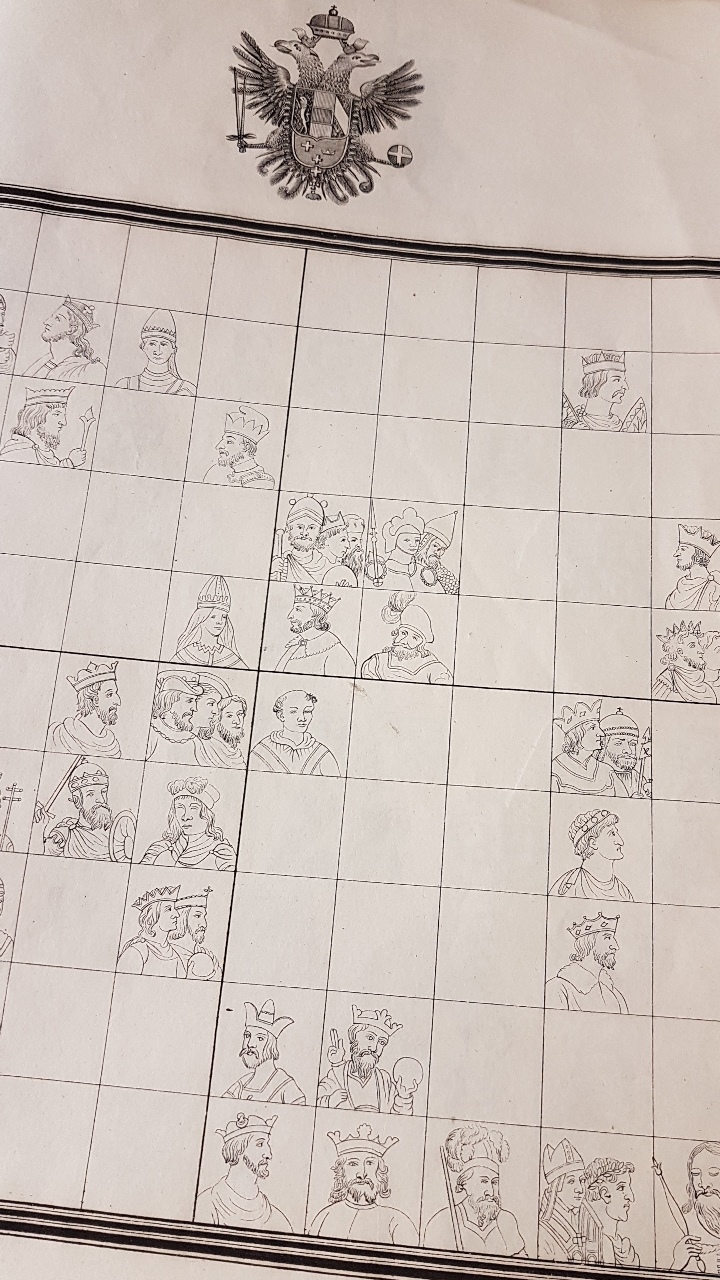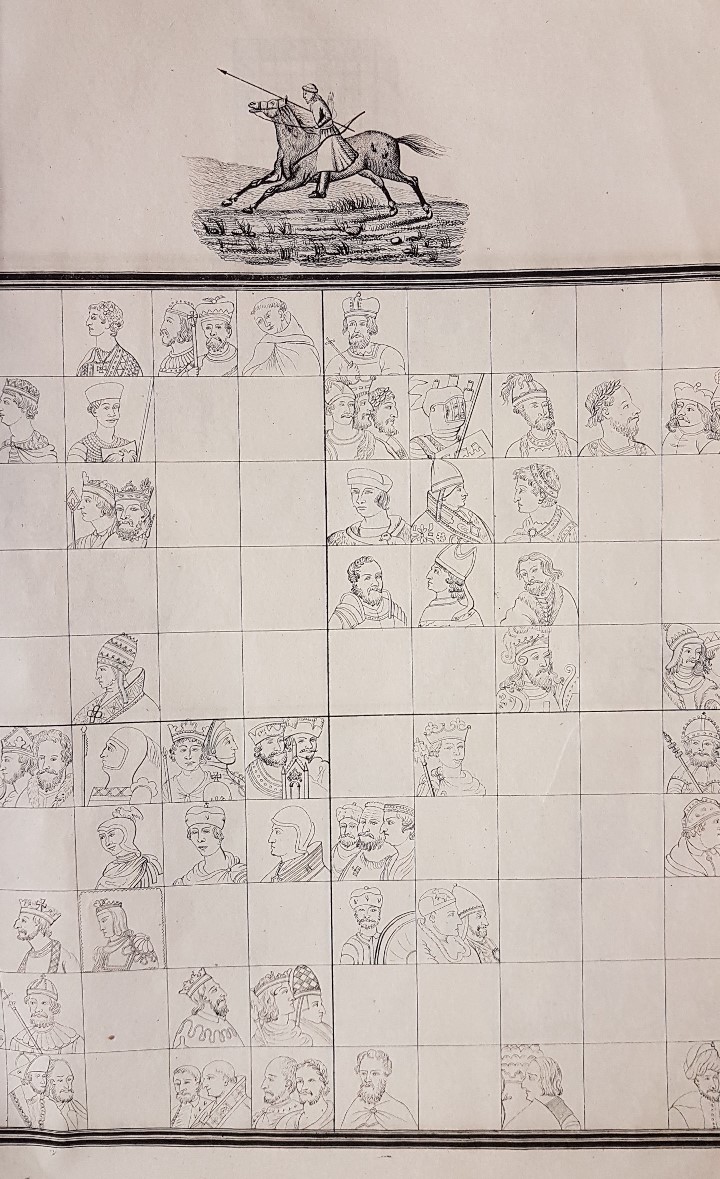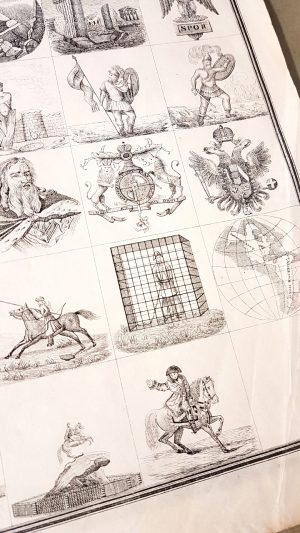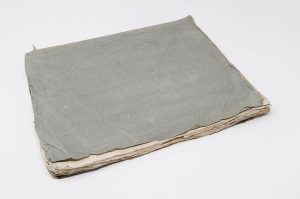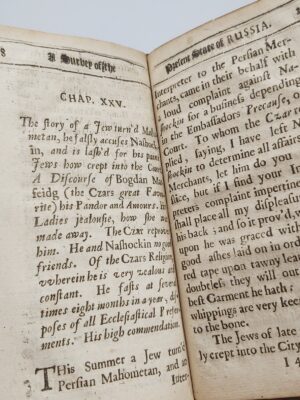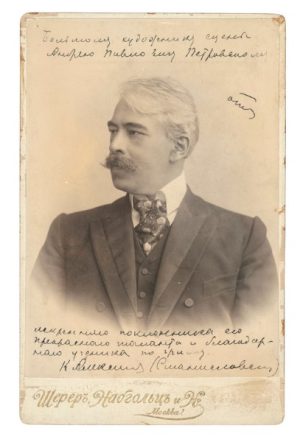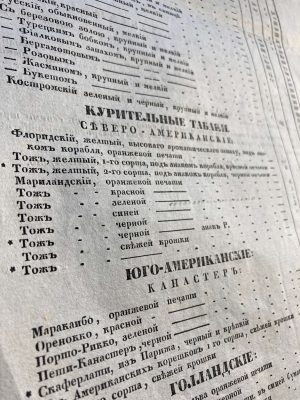Our Notes & References
An innovative Russian teaching method based on visual memory, which met some success in Europe and Russia in the 1830s and 1840s, but was only partially published. Being the only detailed and illustrated publication concerning Iazvinskii’s invention, these Tables are all the more significant that the core of the method was visual representation itself.
Unlike what the title may suggest, no “atlas” was ever published. A companion text volume to the Tables was published the same year, but seemingly separately: it appeared at the University press in Moscow, and was actually a Russian translation of an earlier (1837) Polish Explanation of the Chronographical Tables (see below).
Very rare. Apparently no copy of the Tables in WorldCat, but we could find two in Russia (RNB and SHPL). No copy recorded on the market outside Russia. We could trace only one example of the Russian Explanation: the Yudin copy in the Library of Congress.
The Synchronous Tables feature portraits of European monarchs and images of key events of the world history. In the first table, centuries are represented by a symbolic picture of a prominent event, e.g. the 1st Century AD is represented by a picture of the Nativity. The tables cover the period from the 5th Century BC to the 19th century, the last century being represented by a picture of Napoleon. The 2nd century shows Marcus Aurelius on horseback; the 3rd century is represented by a woman symbolising the Roman Empire, with the Aurelian Wall in the background, signifying Rome’s wars with the barbarians. The 12th century is marked by a picture of a scimitar, referencing the fall of Jerusalem in 1187. The 15th century is marked by a picture of the Americas; the 16th century is the century of Philip II of Spain; the 17th century is represented by Louis XIV and the 18th, by Peter I. In the table for the 19th century, the “Age of Napoleon”, the square for 1804 features Napoleon, who proclaimed himself Emperor of the French that year. The square “1806” features Napoleon, Alexander I of Russia, and Frederick William III – a reference to the War of the Fourth Coalition against France. In the “1814” square, Louis XVIII, King of France from 1814 to 1824, is identifiable, and in the “1824” square – his successor, Charles X. The “1837” square features Queen Victoria.
Iazvinskii (fl. 1830-60) was a Russian educator and author of several textbooks. After graduating from Vilnius Imperial university, created by Alexander I, with a doctorate in philology, and travelled around Europe (France, Prussia, Italy, Switzerland) advertising his mnemonic method. He settled in Paris, where he opened a public course in chronology. News about his method first appeared in the Russian press in 1834. Prince Meshcherskii, from the Russian Embassy in Paris, sent a report about Iazvinskii to the Minister of National Education Uvarov; in 1836 Uvarov allowed Iazvinskii to try out his method at the Pedagogical Institute in St Petersburg.
The first publication outlining Iazvinskii’s method was an article in the Journal of the Ministry of National Education (1834, Part I, pp. 196-213). The method was designed for parts of the curriculum requiring lengthy memorisation, e.g. historical dates, and was based on the use of special tables. His tables typically consisted of one big square divided into 100 little squares; in the synchronous tables, each little square represented 1 year; in the tables for learning languages, each little square represented a sound or a letter. Iazvinskii argued that his method was not just a mechanical memory aid: it could also be used analytically. For example, a long sequence of empty squares in the synchronous tables signalled a long uninterrupted reign of a monarch, which, in turn, could suggest stability.
In 1836 Iazvinskii received the government’s permission to use his method both in selected schools and in his private teaching practice, and soon after Iazvinskii published his first book: The Method of Teaching Chronology and History [Metoda prepodavaniia khronologii i istorii, Akad. Nauk, Skt Peterburg, 1837]. In the same year, a Polish historian, Aleksander Zdanowicz, published in Vilnius his Explanation of the Chronographical Table, Showing Sequential Ascension to the Throne of Emperors and Kings … According to the Iazvinskii Method [Objasìnienie chronograficznej tablicy…]: this shows that the method was already in wide use at the time, not just in Russia, but also in the West.
Zdanowicz’s book (itself a rarity, apparently held only in one library in the West, the National Library of Poland) was translated into Russian by a certain R. Nikulin, student at the Moscow University and published at the university press in 1840 as Obiasnenie khronolog. tablitsy….: this was the closest Iazvinskii and his followers ever came to writing a manual for the use of “chronographic tables” for the world history. The only copy of this Russian edition we could find outside Russia is at the Library of Congress; in Russia we located five library copies, including one at the Russian National Library in St Petersburg.
In 1838 Iazvinskii published a handbook on the use of his chronological method in application to Russian history, titled Rukovodstvo k khronologicheskomu obozreniiu russkoi istorii, A positive review upon publication explained that in Iazvinskii’s tables, asterisks signify years of ascension, and dots – years of memorable events; it also mentioned Iazvinskii’s plan to publish a a large map, where these symbols would be substituted by images copied from commemoration medals – a plan eventually realised in the Synchronous Tables.
Iazvinskii’s method was inspected by the Ministry of Education three times – in 1838, 1844, and 1846. Every time, it received mixed reviews: it was deemed ineffective for teaching geography and foreign languages; however, it seemed to help students with memorising key dates in history. Following headmasters’ reports, the Ministry declined Iazvinskii’s proposal to make his method mandatory.
Iazvinskii continued his efforts in promoting his method: to increase the amount of teaching materials available for his supporters, he published in 1845 A Chronographic Overview of the Russian History [Khronograficheskoie obozreniie russkoi istorii…], with a table featuring dots and asterisks, and portraits of Russian rulers after drawings by Timm. In 1848, following the government’s decision not to adopt his method, Iazvinskii left St Petersburg and recommenced his teaching practice in Europe (London, Paris, Italy). The last archival document mentioning his name is dated 1860 – he wrote to the new Minister of Education Kovalevskii that he was using his method with his European students.
Iazvinskii also published several handbooks on French, German, and Latin, all of them rare in Western libraries.
Bibliography
Obolianinov 3028. Pashkova. T. I. “Metoda Prepodavaniya Shkolnykh Distsiplin A.F. Yazvinskogo (1830–1850-e пg.): Vzliot i Padeniye”, in Izvestiya Rossiiskogo gosudarstvennogo pedagogicheskogo universiteta im. A. I. Gertsena, no. 192, 2019, pp. 131-142; for the 1838 review: Severnaia pchela, 1838, №116, 26 May.
Physical Description
Folio (31.8 x 25.2 cm.). Lithographed title with ornamental border and 25 lithographic tables printed on verso only.
Binding
Bound in contemporary plain grey wrappers.
Condition
Corners a bit rubbed, occasional creases and light staining, wrappers lightly worn, spine mostly defective, but overall a pleasant example.




